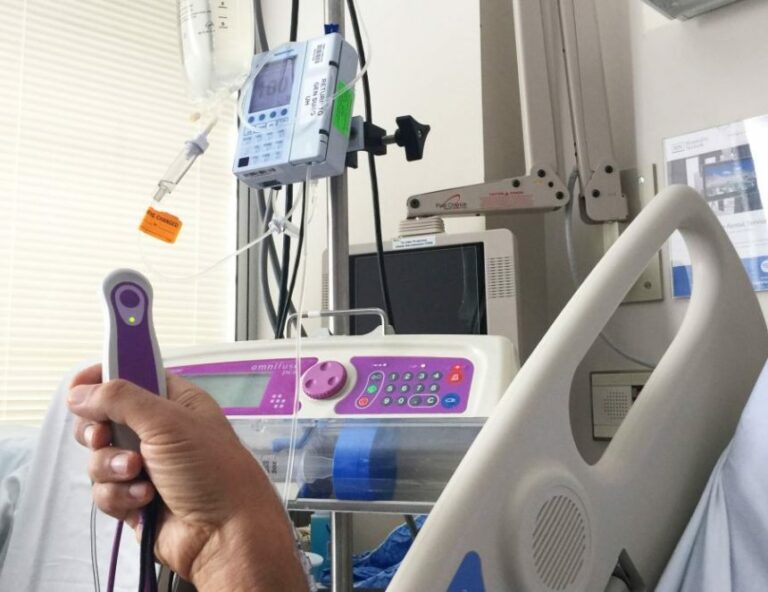Pain is an unpleasant feeling that is conveyed to the brain by nerves in the body.
Acute pain from an injury usually goes away as the injury heals and the original stimulus is removed.
There are two types of pain acute pain and chronic pain
Acute pain is a normal sensation that alerts us to possible injury or is a pain due to recent surgery.
Chronic pain is defined as any pain lasting more than 12 weeks. This pain may have originated from an acute injury such as back strain or can arise from some form of illness.
Pain is subjective and each individual can withstand varying amounts of pain.
Measurement of pain is normally done via a pain scale 0-10 where 0 is No pain and 10 is excruciating.
The pain scale
0-Pain free
1-Pain is very mild barely noticeable. Most of the time you do not think about it
2-Minor pain. Annoying and may have occasional stronger twinges
3-Pain is noticeable and distracting, however, you can get used to it and adapt
4-Moderate pain which begins to interfere significantly with daily living activities. It can be ignored for periods of time but is still distracting
5-Moderately strong pain. It can not be ignored for more than a few minutes but with effort you still can manage to work or participate in some social activities
6-Moderately strong pain that interferes with normal daily activities. Difficulty concentrating
7-Severe pain that dominates your senses and significantly limits your ability to perform normal daily activities and interferes with sleep
8-Intense pain. Physical activity is severely limited and even talking is an effort
9-Excruciating pain. Unable to converse apart from crying out or moaning uncontrollably
10-Unspeakable pain. Bedridden and possibly delirious. Few people experience pain like this.
When describing your pain level to the doctor it is worth telling them how much medication you are currently on.
Pain relief
For simple pain relief either use heat (such as an electric pad, wheatpack or hot water bottle) or cold (such as ice packs)
Cold treatments are best for relieving joint pain, swelling and inflammation
Heat is preferred by people with arthritis and injuries that linger more than 6 weeks.
ICE PACKS
Ice can help minimise swelling around the injury, reduce bleeding into the tissues and reduce muscle spasm and pain. The benefits of ice are generally most effective in the first few days of the injury.
The most commonly use of ice is on fresh injuries such as ligament sprains, muscle injuries, and severe bruises and after some types of surgery.
Ice can also be useful in chronic overuse injuries like carpal tunnel syndrome, tennis elbow, supraspinatus tendonitis, shin splints, and plantar fasciitis.
However many people do use them to control chronic pain in Osteoarthritis and some of the nastier types of inflammatory arthritis such as Rheumatoid arthritis.
To make an ice pack either wrap a gel ice pack or frozen vegetables in a towel( to avoid an ice burn) and apply to the area.
Alternatively you can get some ice cubes and wrap them in a wet tea towel. Fold it up to hold the cubes and then hit it with the rolling pin to crush the ice. This will then mould better to the part to be treated.
There are many different opinions about how long the ice should stay on, but a good start is to keep on for 10 -15 mins and then take off for as long as it takes the tissues to get back to normal temperature and sensation before reapplying for 10-15 minutes.
It is essential that the ice does not cause an ice burn so always have a towel between the ice and the skin.
Be extra careful if you are very old and/ or have very poor circulation.
Leaving ice on too long can do more harm than good as the effect it has is constricting the blood vessels.
This has the effect of reducing the blood flow to the injured area and slow the healing process. So never leave it on longer than 20 minutes.
Is Ice good for Back pain?
Back pain is rarely caused by an injury therefore the pain is not caused by inflammation which might be eased by ice. Even when inflammation is present it is so deep that the effect of ice generally will not reach it.
Generally most back pain results from muscle pain in the form of muscle trigger points, which may even be aggravated by ice rather than eased. In these cases heat would be preferable.

Is it safe to take both Paracetamol and Ibuprofen?
The best way to control pain is to take painkillers regularly. You can take 4 doses of paracetamol in 24 hours. If you are in a lot of pain you can take Paracetamol then 2 hours later Ibuprofen then 2 hours later the paracetamol.
e.g. 7am Paracetamol, 9am Ibuprofen, 11am Paracetamol, 1pm Neurofen. This covers the period from 7am to 7pm. However you can spread it out to 3 hourly to cover a longer period of the day. If taken 3 hourly it would cover you from 6am to midnight.
Painkillers
Paracetamol
The most common painkiller used to treat aches and pains is paracetamol and many elderly people rely heavily on these.
Paracetamol works by blocking the chemical messages in the brain to tell us we have pain.
They take an hour to work and the usual dose is 2x500mg tablets, which can be taken 4 times in 24 hours. Attention must be paid to any other medication that contains Paracetamol such as Co-Codamol ( paracetamol and codeine) or Co-dydramol 9 Dihydrocodeine and Paracetamol)and Tramacet ( Tramadol with paracetamol)
Paracetamol is a very effective and safe drug and can be taken with most prescription drugs including antibiotics.
However it is not suitable for everyone so consult your doctor or pharmacist if you are on warfarin or other medications for epilepsy and TB
Ibuprofen
Another commonly used painkiller
This is a NSAID which means non-steroidal anti-inflammatory drug.
These tend to work better if there is a clear evidence of an inflammatory cause. However these should never be used for long periods as this can cause bleeding in the stomach and also lead to kidney and heart problems.
- Always take ibuprofen tablets and capsules with food or a drink of milk to reduce the chance of an upset stomach. Do not take it on an empty stomach.
- If you’re taking tablets, take the lowest dose for the shortest time. Do not use it for more than 10 days unless you’ve spoken to your doctor. Do not use the gel, mousse or spray for more than 2 weeks without talking to your doctor.
- Ibuprofen is called by different brand names, including Nurofen, Brufen and Calprofen (syrup). Ibuprofen gel can be called Fenbid, Ibugel and Ibuleve.
Some brands of ibuprofen tablets, capsules and syrup contain aspartame, colourings (E numbers), gelatin, glucose, lactose, sodium, sorbitol, soya or sucrose, so they may be unsuitable for some people.
Do not take ibuprofen by mouth or apply it to your skin if you:
- have had an allergic reaction to ibuprofen or any other medicines in the past
- have had allergic symptoms like wheezing, runny nose or skin reactions after taking aspirin or other non-steroidal anti-inflammatory medicines (NSAIDs)such as naproxen
- are trying to get pregnant or are already pregnant
- have high blood pressure that’s not under control
To make sure ibuprofen (by mouth or on your skin) is safe for you, tell your doctor or pharmacist if you have:
- had bleeding in your stomach, a stomach ulcer, or a hole (perforation) in your stomach
- a health problem that means you have an increased chance of bleeding
- liver problems, such as liver fibrosis, cirrhosisor liver failure
- heart disease or severe heart failure
- kidney failure
- crohns Disease
- Shingles
- If you are over 65 Ibuprofen can increase your chance of stomach ulcers so if you need to take them your doctor can prescribe something to protect your stomach
The usual dose for adults is one or two 200mg tablets 3 times a day. In some cases, your doctor may prescribe a higher dose of up to 600mg to take 4 times a day if needed. This should only happen under supervision of a doctor.
If you take ibuprofen 3 times a day, leave at least 6 hours between doses. If you take it 4 times a day, leave at least 4 hours between doses.
If you have pain all the time, your doctor may recommend slow-release ibuprofen tablets or capsules. It’s usual to take these once a day in the evening or twice a day. Leave a gap of 10 to 12 hours between doses if you’re taking ibuprofen twice a day.
For people who find it difficult to swallow tablets or capsules, ibuprofen is available as a tablet that melts in your mouth, granules that you mix with a glass of water to make a drink, and as a syrup.
Swallow ibuprofen tablets or capsules whole with a glass of water or juice. You should take ibuprofen tablets and capsules after a meal or snack or with a drink of milk. It will be less likely to upset your stomach.
Do not chew, break, crush or suck them as this could irritate your mouth or throat.
It’s safe to take ibuprofen with paracetamol or codeine.
How to use ibuprofen gel, mousse or spray
The amount of ibuprofen you put on your skin depends on the product you’re using – check the package leaflet carefully for how much to use.
Gently massage the ibuprofen into the painful area 3 or 4 times a day. Leave at least 4 hours between applications, and do not put it on more than 4 times in 24 hours.
Never use ibuprofen gel, mousse or spray on your eyes, mouth, lips, nose or genital area. Do not put it on sore or broken skin. Do not put plasters or dressings over skin you’ve applied ibuprofen to.
The common side effects of ibuprofen taken by mouth happen in more than 1 in 100 people. Talk to your doctor or pharmacist if these side effects bother you or don’t go away:
- headaches
- feeling dizzy
- feeling sick (nausea)
- being sick (vomiting)
- wind
- indigestion
Serious side effects
Call a doctor straight away if you have:
- black poo or blood in your vomit – these can be signs of bleeding in your stomach
- swollen ankles, blood in your pee or not peeing at all – these can be signs of a kidney problem
- severe chest or stomach pain – these can be signs of a hole in your stomach or gut
- difficulty breathing, or asthma symptoms that become worse
- a skin rash that may include itchy, red, swollen, blistered or peeling skin
- wheezing
- tightness in the chest or throat
- problems breathing or talking
- swelling of the mouth, face, lips, tongue or throat
- These are warning signs of a serious allergic reaction. A serious allergic reaction is an emergency.
Ibuprofen doesn’t mix well with some medicines.
Ibuprofen applied to the skin is less likely to interfere with other medicines than if it’s taken by mouth.
For safety, tell your doctor if you’re taking these medicines before you start taking ibuprofen by mouth or using it on your skin:
- blood-thinning medicines such as warfarin
- anti-inflammatory painkillers such as aspirin, diclofenac, mefenamic acid and naproxen
- medicines for high blood pressure
- steroid medicines such as betamethasone, dexamethasone, hydrocortisoneor prednisolone
- antibiotics such as ciprofloxacin, levofloxacin, moxifloxacin, nalidixic acid, norfloxacin or ofloxacin
- antidepressants such as citalopram, fluoxetine, fluvoxamine, venlafaxine, paroxetineor sertraline
- diabetes medicines such as gliclazide, glimepiride, glipizide and tolbutamide
Paracetamol and Ibuprofen can be taken at the same time and to get good coverage of painkillers over the day it is best to take one set then the other set 2 hours later. Ibuprofen works best taken with food so bear this in mind when deciding how to take your tablets. Both drugs can be taken 4 hourly so if you take Paracetamol you can then take ibuprofen 2 hours later and then 2 hours after that Paracetamol again and so on.
Codeine
is another painkiller. However it does not work well alone and is usually combined with paracetamol. You can buy Co-codamol over the counter however it is not recommended for long term use as it can lead you to become dependant on them. It i=also has side effects which include dizziness and constipation.
Amitriptyline (used initially as a drug for depression but found to be effective in pain control) and Gabapentin (an epileptic drug) are often used to treat pain caused by nerve sensitivity or nerve pain caused by conditions such as sciatica, shingles or diabetes.
These have to be prescribed by a GP
Morphine
This is one of the strongest painkillers and can be prescribed as a patch, an injection or sometimes a pump you control yourself.
belongs to a class of drugs known as opioid(narcotic) analgesics. It works in the brain to change how your body feels and responds to pain.
They are often used immediately after surgery for the first few days and can be very effective for short term use .
Treating Pain after surgery
Pain after surgery is known as acute pain. The cause is known and the pain will ease as the tissues heal. Post-operative pain is normal and can make you feel like lying still and breathing more shallowly which is not good for the body and can lead to complications such as pneumonia and clots.
This makes it important to control the level of pain so that you can start to become active again and breath more normally. So do not try to be brave and refuse tablets. It is very important to manage pain early to avoid it becoming chronic.
You will be directed by health care professionals as to what movements and activities you can start and they will check on your progress.
You will be offered different pain medicines depending on the level of pain you are feeling.
Opioids are critical for post-surgical pain management because of the drug’s powerful effect. But side effects can be significant, including nausea, vomiting, constipation, urinary retention, drowsiness, impaired thinking skills and poor respiratory function.
Overdosing and abuse of opioids also are risks, particularly when opioids are used to treat on-going (chronic) pain. While the use of opioids after surgery is intended as a short-term strategy to relieve pain while the body heals, the risk of abuse is still a concern.
There has been a lot of attention in the press recently about the growing problem of opioid overdose and misuse. Doctors are being discouraged from doling out opioids for chronic pain and are being encouraged to educate their patients, to screen and regularly reassess for their misuse, to assess pain management regularly, and to use non-opioid drugs when possible.
See article Sunday Times March 10th 2019 Anthony Gregory
People are being encouraged to :
- Take medication only as directed, minimizing dosage and duration of opioid use
- Talk to your doctor when your pain is not under control
- Not use alcohol while taking opioids
- Follow the doctor’s instructions about other drugs not to take while using opioids
- Store drugs safely
- Dispose of unused drugs, ideally through a pharmacy take-back program
- Not share your medication with other people
A primary goal of pain management after major surgery is for you to awaken relatively comfortable and to experience an uninterrupted transition to pain control, but some discomfort is common and should be anticipated after surgery.
Intravenous (IV) pain medication
Before surgery, you’ll probably have a slender plastic tube (catheter) inserted into a vein in your hand or arm to give you fluids, sedatives, anesthetics, antibiotics or pain medications. The catheter can be used for delivering pain medications until you can take pills by mouth.
Pain relievers, such as opioids, are usually injected into your IV catheter at regular intervals. Most hospitals also offer patient controlled analgesia (PCA) — a system that allows you to give yourself a fixed dose of the medication by pushing a button. This way you don’t have to ask a nurse for each dose of pain medicine.
The PCA system has built-in safeguards to prevent you from overdosing on pain medication. If you push the button more than once within a set period of time, the dispenser ignores the second request.


Epidural analgesia
In epidural analgesia, pain medications are injected through a catheter inserted into the epidural space within your spinal canal but outside your spinal fluid. An epidural catheter is often used to avoid a general anaesthetic and to control post-operative pain after major abdominal surgery.
The epidural catheter can be left in place for several days if needed to control postoperative pain. A continuous infusion of pain relievers, including local anaesthetics or opioid medications, can be delivered through the catheter to control pain.
Patient controlled epidural analgesia (PCEA), similar to PCA, enables you to give yourself a dose of the pain medication by pushing a button. It, too, has built-in safeguards so that you don’t give yourself too much medication.
Spinal anaesthesia
Some surgeries can be done with spinal anaesthesia, which involves medications injected directly into the spinal fluid. Spinal anaesthesia is easier and faster than epidural analgesia is, but it doesn’t last as long because there’s no catheter to allow the administration of additional medication. Your doctor can add a long-acting opioid to the spinal medication that can relieve post-surgical pain for up to 24 hours.
Nerve block
A nerve block uses a local anaesthetic to provide targeted pain relief to an area of your body, such as an arm or leg. It prevents pain messages from traveling up the nerve pathway to your brain. Nerve blocks can be used for outpatient procedures or more-involved inpatient surgery.
For pain relief lasting several hours, an injection is used for a nerve block. For longer pain control, a catheter may be inserted for continuous medicine delivery or patient-controlled delivery.
Wound infiltration anaesthesia
Your surgeon may inject an anaesthetic drug at the wound site during the procedure or place a catheter for post-surgical drug delivery. This means of local anaesthesia may reduce the use of opioids during your recovery.
Pain relief after minor surgery and during home recovery
Your doctor will provide you with instructions for general post-surgical care, such as rest, ice packs, rehabilitative exercises and wound care. Ask to have written instructions to bring home with you.
For minor surgeries these steps may be the primary means for pain management. After major surgery, they will help you with a more comfortable transition off medication.
You will likely switch to oral pain medication before leaving the hospital and continue to take them at home to manage pain. You will probably take a combination of drugs in pill form, which may include the following:
- Opioids
- Acetaminophen
- NSAIDs, such as ibuprofen and naproxen
As with pain management in the hospital, the combination of drugs that you use at home can result in fewer opioid side effects and lower the risk of opioid dependence.
Be sure to understand what active ingredient is in each pain medication and ask your doctor or pharmacist about possible interactions with over-the-counter drugs you might use, such as cold medicine, or other prescription medications or supplements you regularly take.
Your role in pain control
After surgery, work with your health care team to make your recovery as prompt and pain-free as possible. You’ll need to communicate with your doctors and nurses to help them assess and adjust the pain management plan.
- Be honest about the pain you feel after surgery- Let your doctors and nurses know how much it hurts, where it hurts, and what activities or positions make it better or worse. Your health care team will want to know the intensity of pain on a 0 to 10 scale, where 0 is no pain and 10 is the worst pain you can imagine. The more specific you can be, the better your doctors can help you.
- Don’t ignore side effects- Tell your care team if you experience sleepiness, constipation, nausea or other side effects of the medications. A different pain medication or dose can sometimes reduce uncomfortable side effects, and these side effects can often be treated and relieved.
- If you have been on morphine or Oxycodone these will need to be reduced slowly. You should keep taking the paracetamol while you gradually reduce and stop the other painkillers such as opiates, and NSAID’s.
- It is also known that there are effective non-drug treatments, which can help control pain such as relaxation and distraction techniques. Simple relaxation techniques with abdominal breathing and listening to relaxing music can help.
- Supporting the wound when coughing, deep breathing or moving after surgery can be very helpful.
- Massage can also help relax tense muscles
Sources are NHS site, Mayo clinic, Royal Marsden

